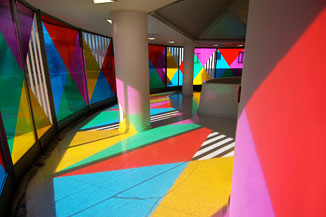
 |
|||
 |
|
|
|
Throughout his career Daniel Buren has radically questioned the nature of art and the systems that support and manipulate it. At the same time, he has successfully worked within the institutions that are an integral part of this cultural machine. Born in Boulogne-Billancourt, outside Paris, in 1938, Buren began painting in the early 1960s and after a short but prolific period of experimentation with this medium, the artist discovered the striped material that would become his signature. By 1965 the artist had begun making paintings with a linen pre-printed with alternating bands of white and color that he found at the MarchÈ Saint-Pierre, a textiles market in Montmartre, Paris. By reducing his paintings to their simplest visual and physical elements, emptying them of all illusion and subjectivity, Buren questioned the traditional expectations of the form, though he often applied acrylic to the outermost white stripes to differentiate the fabric from a found object. His interest in the literal components of the work, which consisted of both surface and support—the recto and verso—would lead him to explore aspects (both material and ideological) of a work of art that are not visible: what conventional painting, in fact, masks. [MORE] ABOVE: Color, Rhythm, Transparency, work in situ: The Single Frieze, Thannhauser 4, 2004–05, Solomon R. Guggenheim Museum, New York. Photo: Daniel Buren. SPLASH PAGE: Around the Corner, 2000–05, and The Rose Window, 2005, works in situ, Solomon R. Guggenheim Museum, New York. Photo: David M. Heald, © SRGF, N.Y. For more information on Daniel Buren, visit www.danielburen.com. |